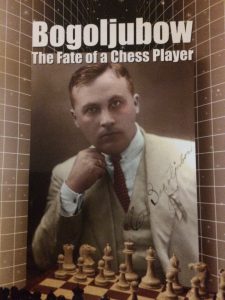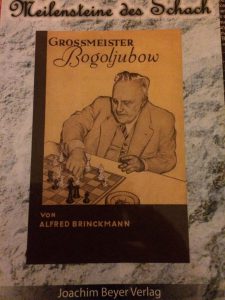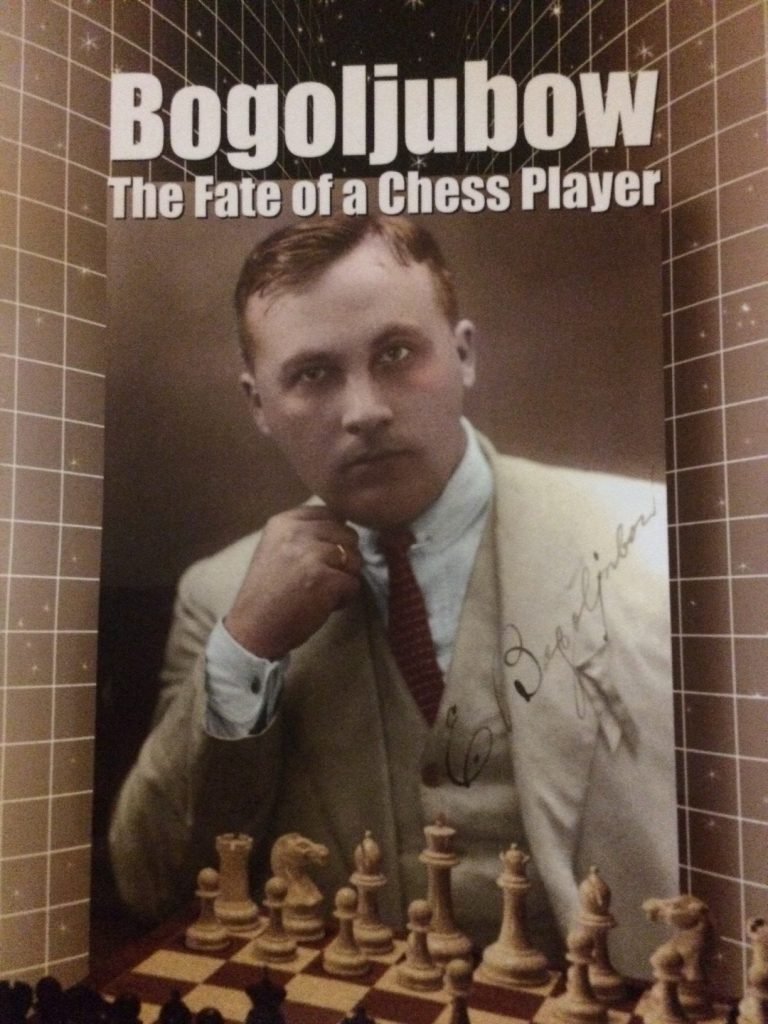Most of my chess activities nowadays take place in the train on the way to work. A recent spate of engineering works has lengthened my journey considerably with the happy result that I’ve been studying chess for an extra half hour a day!
I’ve spent that time playing through lots of Efim Bogolyubow’s games from Sergei Soloviov’s excellent biography “Bogolyubow: The Fate of a Chess Player”. A famous position from his game against Nimzowitsch in Berlin 1927 caught my attention and proved very fruitful to analyse!

Bogoljubow,Efim – Nimzowitsch,Aaron
Berlin 1927
1.d4 Nf6 2.c4 e6 3.Nf3 b6 4.g3 Bb7 5.Bg2 Bb4+ 6.Bd2 Bxd2+ 7.Nbxd2 c5 8.dxc5 bxc5 9.0–0 Qc7 10.Qc2 0–0 11.Rad1 h6 12.a3 Nc6 13.Rfe1 Rab8 14.Rb1
Insipid opening play like this is perhaps the main reason I sometimes have difficulty seeing Bogolyubow as a leading player of his generation. The combination of 7.Nbd2 and 8.dxc5 is already strange (if you’re planning to meet …c5 with dxc5, then it’s much more natural to aim for Nc3 and to take on d2 with the queen). Early middlegame moves like 11.Rad1, 13.Rfe1, and 14.Rb1 also give a planless impression. You’d expect more from a player who challenged Alekhine twice for the World Championship and who was recognised in his time as an authority on openings!
14…a5 15.b3 Rfd8 16.Rb2 Ne7 17.e4 d6 18.Nb1 Nc6 19.Nc3 Qe7 20.Nb5 Ba6 21.Qe2 Nd7 22.Rd2 Nde5 23.a4 Nxf3+ 24.Qxf3 Rd7
24…e5 followed by …Nd4 was the most secure way to establish a knight on d4.
25.Qc3 Qd8 26.Red1 Bxb5 27.axb5 Nd4 28.Rxd4 cxd4 29.Qxd4
This is an interesting, unbalanced position. White has a pawn for the exchange and the pawn structure is favourable for the fight against 2 rooks.
First of all, there are no open files. Secondly, Black’s pawn breaks are impossible to achieve without a great deal of cooperation from White:
- …d5 can be met by exd5 and Bxd5, or as later in the game by Bf1, exd5 and c5
- …a4 is impossible to force: White can even play his rook to a4 if he wants.
Black might be able to organise a break on the kingside (…f5) but this also increases the scope of White’s light-squared bishop and is certainly not without risk. From White’s point of view, the structure is very pleasant because White has free rein to concentrate his major pieces on 2 exposed targets:
- the isolated pawn on a5
- the backward pawn on d6
Another major idea for White is the attempt to mobilise his queenside pawns with the pawn sacrifice e4-e5 creating 2 passed pawns on the b and c files after …dxe5. The big question is whether Black should play …e5 himself to stop this plan. In my opinion, White is unlikely to be able to achieve anything significant after Black’s plays …e5. A move like f4 to gain space on the kingside is very risky while White does not have the firepower himself to force the win of the a-pawn if Black is careful. The most likely result after …e5 is a draw. If Black avoids …e5, then he must be constantly on the lookout for White’s possibility of e4-e5 himself.
In general, I would rather be White here. Black has some difficult decisions to make. If he plays …e5 then only White is a likely winner (with a draw as the most likely result); if Black avoids …e5, then the calculating strain is much bigger every move as e4–e5 is constant source of danger.
29…Rbb7
To prevent e5, but it wasn’t strictly necessary at the moment
29…Qc7 30.e5 can be met by 30…d5 If White cannot achieve c5, then Black will be at least fine. 29…e5 is the very safest way of playing
30.Ra1 Qc7 31.Bf1
An ingenious move, with the aim of supporting c4–c5 by giving the pawn on b5 additional protection. The pawn on c4 is also protected in case Black decides to try and weaken this element of White’s queenside structure with an …a5–a4 pawn sacrifice.
31…Qc5 32.Qe3
I like this move a lot though Komodo is pretty restrained in his praise! The idea behind …Qc5 was pretty ingenious:
- Black offers the exchange of queens and tempts White to win a second pawn for the exchange by grabbing the a-pawn. In that case however. Black also forces the exchange of rooks with a decisive advantage:
32.Qxc5 dxc5 33.Rxa5 Ra7 34.Rxa7 Rxa7 35.e5 is a line of Soloviov’s that I do not understand. 35…Ra3 36.b4 leads to all sorts of adventures indeed but simply 35…Kf8 is very good for Black.
- Black occupies the c5 square which means that White cannot meet a subsequent …d6-d5 (now possible because White’s light-squared bishop has left the h1-a8 diagonal) with c4-c5.
However, 32.Qe3 makes a mockery of Black’s ingenuity! White allows Black to exchange the queens and throws in appalling doubled pawns to boot!
Black has several possibilities:
- 32…Qxe3 33.fxe3
threatens Rxa5. Since the exchange of queens has taken place on e3 instead of c5, White can meet a subsequent …Ra7 from Black with b4.
33…Ra7 34.e5 dxe5
32…Ra7 33.e5 Qxe3 34.fxe3 dxe5 is the move order Soloviov gives in his book. The strong e4-e5 break frees White’s queenside pawns
35.b6 Rab7 36.c5 wins
- 32…Qc7
is suggested by both Soloviov and Alfred Brinckmann in his book “Großmeister Bogoljubow” as the safe option, repairing the damage done with his previous move. It’s not that simple however!

33.e5
33.Qc3 Rxb5 A common trick!
Black now has 2 interesting alternatives:
a. 33…dxe5 34.c5
ai. 34…Rd5
For a while, I now got caught up in all sorts of violent attempts! They work quite well but they aren’t completely necessary!
ai1. 35.c6 Rbxb5 36.Bxb5 Rxb5 37.Rc1 Rd5 should be equal
ai2. 35.b4
35…axb4 36.Ra8+ Kh7
36…Rb8 37.b6 Qd8 38.Rxb8 Qxb8 39.c6; 36…Rd8 37.b6 Qe7 38.Rxd8+ Qxd8 39.Qe4 Rb8 40.Qxb4 Komodo likes White a lot!
37.c6 Rb6 38.Qe4+ g6 39.Qh4
39.Qxb4 looked awkward already but Komodo finds a nasty refinement
39…Kg7 40.Qxb4 Rd8 41.Rxd8 Qxd8 42.Qc3 Qc7 43.f4
using the pin created along the a1–h8 diagonal!
ai3) 35.Rc1
This is probably just as good! White causes Black serious problems just by holding the pawn on c5! b6 and Bg2 is coming.
aii. 34…Rd4 35.Rc1
This is also strong in this position. The threat is b6 when the pawn on e5 cannot be defended.
35…f6 36.b6 Qd8 37.Qc3
A really strong move, giving the c-pawn an extra boost on the way to queening while attacking the a5 pawn. White is winning.
b. 33…d5
The most challenging reply
34.c5
34.Rc1 d4 35.Qd2 is also pretty good for White, but the text is based again on a violent approach that Komodo underestimates at first
34…d4 35.Qc1 Rd5 36.b4
36.c6 Rbxb5 37.Bxb5 Rxb5 38.Qc4 Rb6 39.Rc1 d3 is equal
Now the position gets very sharp:
bi. 36…axb4 37.Ra8+
bi1) 37…Rb8 38.b6 Qd8 39.Rxb8 Qxb8 40.c6 Qxb6 41.c7 wins;
bi2) 37…Rd8 38.Rxd8+
38.b6 Qe7 39.Rxd8+ Qxd8 40.Ba6 Re7 41.Qc4 looked good but not that easy. Komodo thinks White has a clear advantage
38…Qxd8 39.c6
Komodo. A surprising way of advancing the pawns!
39…Re7 40.Qc5
b6 is a massive threat
40…d3 41.Qd6
is the amazing point
bi3) 37…Kh7
bi31) 38.c6 Rbxb5 39.Bd3+ g6 40.Bxb5 Rxb5 41.Qf4 Qe7
41…Rc5 42.Qf6 Rc1+ 43.Kg2 Qxc6+ 44.Kh3 Qxa8 45.Qxf7+ is another Komodo draw
42.Rd8
Komodo!!
42…Rd5 43.Rxd5 exd5 44.Qxd4 Qe6 45.c7 Qc6 46.Qa7 b3
leads to a draw according to Komodo
47.c8Q Qxc8 48.Qxf7+ Kh8 49.Qf6+ Kh7 50.e6 b2 51.Qxb2 Qxe6;
bi32) 38.Bd3+ g6 39.Qf4 f5
Komodo
39…Qe7 40.c6
40.c6 Ra7
40…Rb8 41.Rxb8 Qxb8 42.Qc1 and Black cannot stop the c-pawn! Missed by Komodo for a little while!
41.Re8 Qf7 42.Rc8 Rc7 43.Rb8 is pretty unpleasant for Black
bii) 36…d3
threatening …Rxb5. I thought Black’s counterplay was coming fast but eventually Komodo finds an excellent reply.
37.b6
37.Rxa5 d2 38.Qd1 Qxe5 39.b6 Qc3 looked pretty good to me
37…Qxe5
37…Qd8 38.bxa5 d2 39.Qc2 d1Q 40.Rxd1 Rxd1 41.c6 Komodo!
38.Ra2
An amazing Komodo move!
38.c6 Komodo thought this was good for a long time but I’d already found 38…d2 39.cxb7 dxc1Q 40.Rxc1 Kh7 41.Rc8 Rd1 42.b8Q Qe1 winning
38…Kh7
38…axb4 39.c6 Rxb6 40.c7 is better for White
39.bxa5 Rxc5 40.Qd2
Komodo. The passed pawns are too strong.
It looks therefore as if 32…Qc7 wasn’t a safe option at all!
32…Kf8 33.Rxa5
The text is simple and obvious but 33.e5 Qxe3 34.fxe3 Ke7 35.Rxa5 dxe5 36.c5 also looks pretty dangerous!
33…Ra7
The decisive blunder. 33…Qxe3 34.fxe3 e5 (34…Ke7 35.e5) is still not lost for Black (Komodo only sees a slight advantage for White which really surprises me!) although White enjoys great queenside potential after b4. One moment of inattention from Black and the pawns start to roll!
34.b4 Qxe3 35.fxe3
e4–e5 is a big threat now so Black is forced to spend a tempo preventing it. Now the drawbacks to the blunder 33…Ra7 come to light: White’s queenside pawns are free to advance en masse!
35…e5 36.Bh3 Re7 37.b6 Rab7 38.c5 Re8 39.Ra6 1–0




That game made a plus score against Nimzowitch. Bogoljubov had a bad score against the World Champions and Vidmar and Maroczy. Almost equal against Nimzowitch, Rubinstein, Marshall. Plus score against Spielmann, Reti and Tartakower. I would have liked to see how Bogoljubov would have done in New York 1927 but he declined to participate (money and a controversy with Alekhine).
Efim Bogoljubov beat Rudolf Spielmann 18 to 12, with 7 draws (http://www.chessgames.com/perl/chess.pl?pid=10614&pid2=10264)
Efim Bogoljubov beat Carlos Torre Repetto 2 to 0 (Torre was Top10 on Chessmetrics 1927; http://www.chessgames.com/perl/chess.pl?page=1&pid=10614&pid2=12991)
Efim Bogoljubov beat Richard Reti 15 to 7, with 4 draws (http://www.chessgames.com/perl/chess.pl?page=1&pid=10614&pid2=10626)
Efim Bogoljubov beat Savielly Tartakower 10 to 7, with 8 draws (http://www.chessgames.com/perl/chess.pl?page=1&pid=10614&pid2=10247)
Efim Bogoljubov beat Aron Nimzowitsch 7 to 6, with 5 draws (http://www.chessgames.com/perl/chess.pl?pid=10614&pid2=10249)
Efim Bogoljubov beat Akiba Rubinstein 14 to 13, with 10 draws (http://www.chessgames.com/perl/chess.pl?page=1&pid=10614&pid2=10841)
Efim Bogoljubov tied Frank James Marshall 2 to 2, with 4 draws (http://www.chessgames.com/perl/chess.pl?page=1&pid=10614&pid2=10309)
Jose Raul Capablanca beat Efim Bogoljubov 5 to 0, with 2 draws (
http://www.chessgames.com/perl/chess.pl?pid=10614&pid2=47544)
Emanuel Lasker beat Efim Bogoljubov 5 to 1, with 2 draws (http://www.chessgames.com/perl/chess.pl?pid=10614&pid2=19149)
Alexander Alekhine beat Efim Bogoljubov 36 to 16, with 40 draws (http://www.chessgames.com/perl/chess.pl?pid=10614&pid2=10240)
Max Euwe beat Efim Bogoljubov 11 to 10, with 22 draws (http://www.chessgames.com/perl/chess.pl?page=1&pid=10614&pid2=10706)
Milan Vidmar beat Efim Bogoljubov 5 to 1, with 5 draws (http://www.chessgames.com/perl/chess.pl?pid=10614&pid2=10226)
Geza Maroczy beat Efim Bogoljubov 7 to 4, with 4 draws (http://www.chessgames.com/perl/chess.pl?pid=10614&pid2=10004)
Hi Carsten, thanks for your comment. Yes Bogolyubow generally had a good record against all his peers with the exception of the geniuses Alekhine, Capablanca and Lasker. In his best years (1925-1930) he was probably the 3rd or 4th strongest player in the world. He wouldn’t have challenged Capablanca at New York 1927, but he would have been challenging for second place. Best Wishes, Matthew